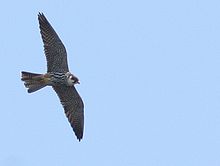Eurasian hobby
| Eurasian Hobby | |
|---|---|

| |
| Scientific classification | |
| Kingdom: | |
| Phylum: | |
| Class: | |
| Order: | |
| Family: | |
| Genus: | |
| Species: | F. subbuteo
|
| Binomial name | |
| Falco subbuteo Linnaeus, 1758
| |
The Eurasian Hobby (Falco subbuteo), or just simply Hobby, is a small slim falcon. It belongs to a rather close-knit group of similar falcons often considered a subgenus Hypotriorchis.[2] This species was first described by Linnaeus in his Systema naturae in 1758 as Falco subbuteo.[3]
This species breeds across Europe and Asia. It is a long-distance migrant, wintering in Africa.
Adults are slate-grey above, and streaked lengthwise below, with a white throat. Close views enable the red "trousers" and vent to be seen. Sexes are similar, but juveniles are generally much browner.
It is a bird of open country such as farmland, taiga and savannah. They are widespread in lowlands with scattered small woods.
It is an elegant bird of prey, appearing sickle-like in flight with its long pointed wings and square tail. It will take large insects, such as dragonflies, which are transferred from talons to beak and eaten in flight. It also captures small birds in flight. Its speed and aerobatic skills enable it to take swallows and even swifts on the wing, and Barn Swallows or House Martins have a characteristic "hobby" alarm call.
Hobbies nest in old nests of crows and other birds, laying 2-4 eggs.
A range of board games was also once going to be named "Hobby", but the inventor, Peter Adolph, was refused permission by the Patent Office on the grounds that it was too generic. The inventor, who was also a birdwatcher, simply used the scientific name of the Hobby and called the board game Subbuteo.[4]
The Hobby has a distinct first-summer plumage.[5]
Footnotes
- ^ Template:IUCN2007 Database entry includes justification for why this species is of least concern
- ^ Helbig et al. (1994), Wink et al. (1998), Nittinger et al. (2005)
- ^ Template:La icon Linnaeus, C (1758). Systema naturae per regna tria naturae, secundum classes, ordines, genera, species, cum characteribus, differentiis, synonymis, locis. Tomus I. Editio decima, reformata. Holmiae. (Laurentii Salvii). p. 89.
F. cera pedibusque flavis, dorso fusco, nucha alba abdomine pallido maculis oblongis fuseis.
- ^ The Times: Table-topping star of the big flick-off. Version of 2006-OCT-16. Retrieved 2007-AUG-12.
- ^ Small, Brian (1992): First-summer Hobbies in the New Forest British Birds 85(5): 251-5
References

- Helbig, A.J.; Seibold, I.; Bednarek, W.; Brüning, H.; Gaucher, P.; Ristow, D.; Scharlau, W.; Schmidl, D. & Wink, Michael (1994): Phylogenetic relationships among falcon species (genus Falco) according to DNA sequence variation of the cytochrome b gene. In: Meyburg, B.-U. & Chancellor, R.D. (eds.): Raptor conservation today: 593-599. PDF fulltext
- Nittinger, F.; Haring, E.; Pinsker, W.; Wink, Michael & Gamauf, A. (2005): Out of Africa? Phylogenetic relationships between Falco biarmicus and other hierofalcons (Aves Falconidae). Journal of Zoological Systematics and Evolutionary Research 43(4): 321-331. doi:10.1111/j.1439-0469.2005.00326.x PDF fulltext
- Wink, Michael; Seibold, I.; Lotfikhah, F. & Bednarek, W. (1998): Molecular systematics of holarctic raptors (Order Falconiformes). In: Chancellor, R.D., Meyburg, B.-U. & Ferrero, J.J. (eds.): Holarctic Birds of Prey: 29-48. Adenex & WWGBP. PDF fulltext

